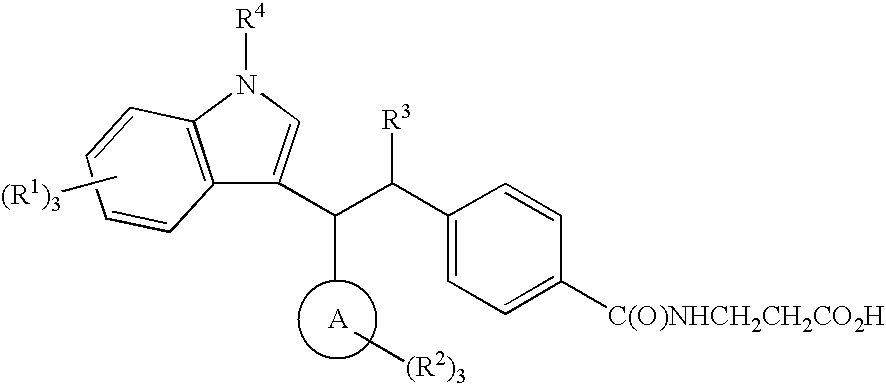Glucagon receptor antagonist compounds, compositions containing such compounds and methods of use
a technology of glucagon receptor and antagonist compound, which is applied in the field of glucagon receptor antagonist compound, can solve the problems of inadequate lipolysis in adipose tissue, insufficient uptake, oxidation and storage of glucose in muscle, and excess glucose production and secretion by the liver
- Summary
- Abstract
- Description
- Claims
- Application Information
AI Technical Summary
Problems solved by technology
Method used
Image
Examples
example 1
N-(4-{1-[(4-CHLOROPHENYL)(5,7-DICHLORO-1H-INDOL-3-YL)METHYL]BUTYL}BENZOYL)-β-ALANINE
[0158]
Step A. Methyl N-{4-[2-(4-chlorophenyl)-1-propylpent-4-en-1-yl]benzoyl}-β-alaninate
[0159] A DMF solution (20 ml) containing INTERMEDIATE 1 (1.66 g, 4.84 mmol), methyl β-alaninate hydrochloride (1.01 g, 7.26 mmol), DIEA (4.3 ml, 24.2 mmol) and BOP (3.21 g, 7.26 mmol) was stirred at room temperature for 1.5 hours. The solution was diluted with EtOAc and washed with water, brine and dried over Na2SO4. The filtered solution was concentrated and the residue purified by silica gel chromatography using a hexanes / EtOAc gradient to give the title compound. 1H NMR for the major diastereomer (500 MHz, CDCl3): δ 7.72 (d, J=8.2 Hz, 2H); 7.28 (d, J=8.3 Hz, 2H); 7.22 (d, J=8.2 Hz); 7.07 (d, J=8.4 Hz, 2H); 6.85-6.81 (m, 1H); 5.41-5.31 (m, 1H); 4.77-4.66 (m, 2H); 3.75-3.70 (m, 2H); 3.73 (s, 3H); 2.81-2.72 (m, 2H); 2.67 (t, J=5.9 Hz, 2H); 2.10-2.05 (m, 2H); 1.40-1.29 (m, 2H); 0.98-0.85 (m, 2H); 0.66 (t, J=7.3 ...
example 2
N-(4-{(1S)-1-[(R)-(4-CHLOROPHENYL)(7-FLUORO-5-METHYL-1H-INDOL-3-YL)METHYL]BUTYL}BENZOYL)-β-ALANINE
[0170]
Step A. Methyl N-(4-{(1S)-1-[(R)-(4-chlorophenyl)(7-fluoro-5-methyl-1H-indol-3-yl)methyl]butyl}benzoyl)-β-alaninate
[0171] An acetic acid solution (10 ml) of methyl N-{4-[2-(4-chlorophenyl)-4-oxo-1-propylbutyl]benzoyl}-β-alaninate, prepared from INTERMEDIATE 2 as described in EXAMPLE 1, (757 mg, 1.76 mmol), ZnCl2 (3.1M in AcOH, 1.7 ml, 5.27 mol) and 2-fluoro-4-methylphenylhydrazine hydrochloride (374 mg, 2.1 mmol) were heated at 80° C. for 45 minutes. The solution was concentrated and the residue partitioned between EtOAc and water. The organic phase was washed with water (2×), brine (2×) and dried over Na2SO4. The solution was filtered, concentrated and the residue purified by silica gel chromatography using a hexanes / ethyl acetate gradient to give the title compound. Data for the major diastereomer: 1H NMR (500 MHz, CD3CN): δ 9.11 (s, 1H); 7.54 (d, J=8.2 Hz, 2H); 7.48 (d, J=8.5...
example 91
4-{1-[(3-CHLORO-4-METHOXYPHENYL)(5,7-DICHLORO-1H-INDOL-3-YL)METHYL]PENTYL}BENZOYL)-β-ALANINE
[0177]
Step A. tert-Butyl N-(4-{1-[1-(3-chloro-4-methoxyphenyl)-3-oxopropyl]pentyl}benzoyl)-β-alaninate
[0178] N-Chlorosuccinamide (40 mg, mmol) was added to an acetonitrile solution (2 ml) containing enantiopure tert-butyl N-(4-{1-[1-(4-methoxyphenyl)-3-oxopropyl]pentyl}benzoyl)-β-alaninate (20 mg, 0.42 mol), which was prepared following the procedure described in EXAMPLE 1. The solution was then heated in a screw cap tube for 35 minutes at 85° C. The solution was concentrated and the residue purified by PTLC using an EtOAC / hexanes eluent to give a mixture of compounds containing the title compound and the corresponding 3,5-diCl analog (˜30% by NMR). LC1 4.00 min. (M+H) 460, di Cl LC1 4.15 min. (M+H) 494 selected data 1H NMR (400 MHz, CDCl3): δ 9.35 (s, 1H); 7.72 (d, J=8.2 Hz, 2H); 7.23-7.15 (m, 3H); 6.86 (d, J=8.4 Hz, 2H); 3.88 (S, 3H); 3.68 (q, J=5.9 Hz, 2H); 3.29-3.23 (m, 1H); 2.75-2.65 (...
PUM
| Property | Measurement | Unit |
|---|---|---|
| body weight | aaaaa | aaaaa |
| body weight | aaaaa | aaaaa |
| body weight | aaaaa | aaaaa |
Abstract
Description
Claims
Application Information
 Login to View More
Login to View More - R&D
- Intellectual Property
- Life Sciences
- Materials
- Tech Scout
- Unparalleled Data Quality
- Higher Quality Content
- 60% Fewer Hallucinations
Browse by: Latest US Patents, China's latest patents, Technical Efficacy Thesaurus, Application Domain, Technology Topic, Popular Technical Reports.
© 2025 PatSnap. All rights reserved.Legal|Privacy policy|Modern Slavery Act Transparency Statement|Sitemap|About US| Contact US: help@patsnap.com



